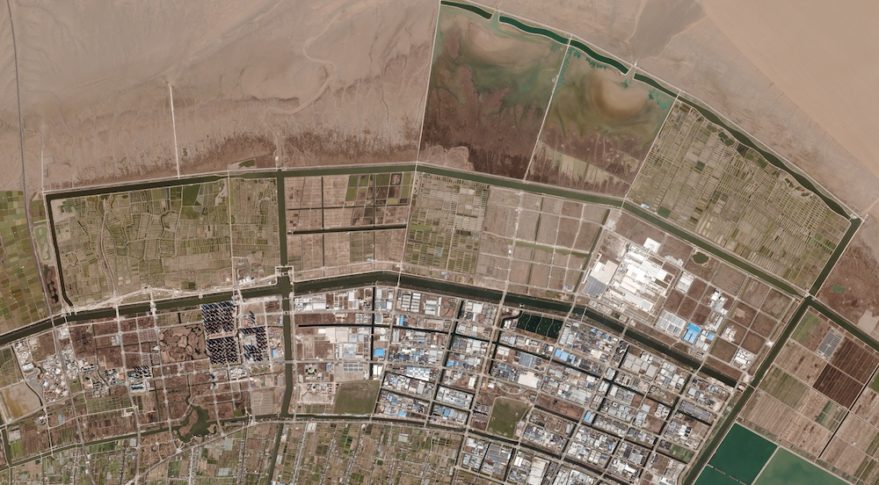US Wargame Highlights Role of Commercial Space Imagery in Military Conflicts

WASHINGTON — Rising military powers like Russia and China have built an elaborate network of sensors to monitor regions of the world that are of strategic importance to the United States. A mix of military and commercial surveillance and targeting technologies is helping both Russia and China extend the reach of their long-range weapons, undermining U.S. access and influence in regions such as Eastern Europe and the South China Sea.
That was the takeaway from a year-long wargame funded by the Defense Department and Pentagon contractors
The research concluded that Russia's and China's sophisticated long-range sensor and weapon networks along their borders and in occupied lands create a "strategic problem" for the United States, said Bryan Clark, a senior fellow at the Center for Strategic and Budgetary Assessments who participated in the wargame. [The Most Dangerous Space Weapons Concepts Ever]
The wargame shed light on the increasing sophistication and availability of satellite imagery as a trend that is playing in favor of U.S. adversaries. Both Russia and China have high-frequency radars that can see well over the horizon, as well as underwater sensor networks that can hear some types of submarines. With the newer constellations of electro-optical satellites, they get unprecedented visibility. "They can tap into commercial satellite networks, which are growing pretty dramatically, for visual and infrared indication," Clark said Wednesday during a briefing at the Association of Old Crows annual conference.
Adversaries' ability to closely monitor strategic regions makes it less likely the United States can prevail in so-called "gray zone" conflicts, Clark said. Russia's annexation of Crimea and intervention in eastern Ukraine, and Chinese activities in the South China Sea are examples of gray zone conflicts — protracted, ambiguous operations that create a situation that makes it almost impossible for the United States to respond effectively.
Russia's and China's homeland defense sensor networks in fact are more advanced than U.S. systems, simply out of necessity. Protecting their territory from nearby threats is "something they worry about," said Clark. "It's not necessarily that their technology is better than U.S. technology. They've invested in this area and we haven't."
Get the Space.com Newsletter
Breaking space news, the latest updates on rocket launches, skywatching events and more!
In a confrontation, China and Russia would likely first use their widest-area search sensors, such as land-based high frequency over-the-horizon radars and passive space-based electronic or signals intelligence receivers to rapidly locate and identify enemy forces. These sensors can continuously survey an entire region such as the South China Sea or the Baltics but generally do not provide target-quality data. The emerging generation of commercial satellite constellations with electro-optical infrared sensors "will soon provide another search sensor with near-continuous surveillance of important regions," said the CSBA report. These commercial systems were designed to supply imagery to customers like farmers and climate change researchers, but they could support military operations for only the cost of a subscription.
CSBA cites one prominent company, BlackSky, that is developing a constellation over the next decade that will provide two-to-three images per hour of the most populated latitudes. Other companies and rival militaries are pursuing similar constellations.
The bottom line for U.S. forces is that they will not be able to avoid detection by this combination of RF, visual, and IR search sensors. What they can do, Clark suggested, is "make U.S. operations difficult to attribute or, more likely, slow an enemy's ability to identify and classify potential U.S. targets."
Old school decoys, jammers, camouflage and smoke to obscure their location would increase the time needed to find U.S. targets. "If the enemy desired to engage U.S. forces quickly, it would need to use more sorties and weapons, the CSBA report said, potentially resulting i a larger attack that may be inconsistent with the gray zone approach.
Clark said BlackSky is one of many companies that are advancing imagery technology and "providing almost ubiquitous coverage." The United States has access to the same technology but it wouldn't necessarily help in conflicts where "we are the away team," Clark told SpaceNews. "We're out there moving around, trying to exploit our mobility to avoid being detected. Both sides have access to commercial sources of imagery but it's more of a problem for the U.S. because we're generally the ones trying to stay hidden." [Military Space: The Tech, Spacecraft and Weapons]
The United States may have to think about resurrecting time-tested military deception techniques. "Satellites are here to stay . But I can put out decoys. Old school camouflage works really well, obscurants, smoke. Stuff that is fairly low tech can be really effective," he added. "I'm trying to create more targets for the enemy so he's forced to think about a larger operation than he's comfortable doing. In this gray zone fight, that's enough to cause him to bail out."
In the wargame, a "blue team" from U.S. Pacific Command became frustrated by the lack of options to respond to aggressions such as intentional jamming of U.S. GPS and communications satellite signals, Clark said. "The blue teams eventually just kind of threw up their hands and said, 'Either I have to escalate and start the war, or I have to sit back and not do a whole lot of anything.'"
This story was provided by SpaceNews, dedicated to covering all aspects of the space industry.
Join our Space Forums to keep talking space on the latest missions, night sky and more! And if you have a news tip, correction or comment, let us know at: community@space.com.

Sandra Erwin covers the military and national security beat as a Senior Staff Writer at SpaceNews. Sandra, based in Arlington, Virginia, specializes in Defense Department and Intelligence Community space programs, policy, budgets, technology and the industry that supports this sector. She joined SpaceNews in October 2017. Before coming to SpaceNews, Erwin covered the U.S. military, the Pentagon, Congress and the defense industry for over two decades as editor of the National Defense Industrial Association's National Defense Magazine and Pentagon correspondent for Real Clear Defense.










